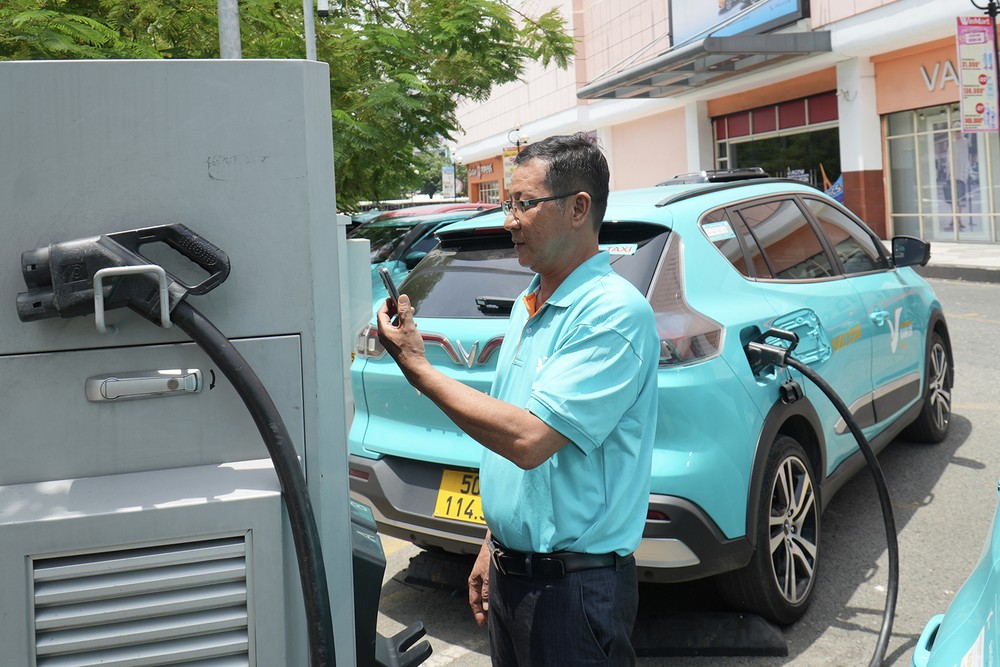
The presence of electric vehicles on the roads of major cities is growing, yet alongside concerns about limited battery charging station infrastructure, there is also a notable absence of many standards and regulations in the management relating to this vehicle category.
Various foreign brands appeared
By the end of 2021, electric cars started gaining attention in Vietnam, particularly after VinFast launched its first all-electric model, the VinFast VF e34. Since then, the electric vehicle market has gradually taken shape, witnessing continuous sales growth. Over the past two years, prestigious car manufacturers like BMW and Mercedes-Benz have also introduced electric vehicle models to Vietnam.
However, with an exploratory approach, these industry giants have yet to fully develop their electric vehicle offerings, failing to meet the demands of customers adequately. Most are still primarily focused on importing a limited range of high-end electric car models, priced between VND3 billion and VND5 billion per vehicle. For example, Mercedes-Benz introduced its EQS electric car line in Vietnam, offering the 450+ and 580 4MATIC models at prices exceeding VND4.8 billion and VND5.9 billion, respectively.
Similarly, for the Vietnamese market, BMW has unveiled two electric models, the i4 and iX3, priced from VND3.4 billion upward. Audi has also introduced several models, including the e-tron, e-tron GT, and RS e-tron GT, with prices starting from VND2.97 billion.
Meanwhile, Chinese electric car manufacturer BYD is determined to gain a foothold in the Vietnamese market with an ambitious plan. They aim to launch 15 out of 30 showrooms nationwide by June. Previously, TMT Motors announced a collaboration with SGMW (a joint venture between SAIC, GM, and Wuling Automobile) to introduce the Wuling Hongguang electric car to the market. It comes in four versions with prices ranging from VND239-279 million per vehicle.
Another Chinese brand, Great Wall Motor (GWM), after introducing the Haval H6 HEV hybrid SUV with a price of over VND1 billion, will bring the Haval Jolion gasoline and hybrid models to Vietnam in the second quarter of 2024.
According to the latest regulations issued by the Ministry of Transport (effective from October 5, 2024), rest stops along expressways and national highways must include charging stations and designated parking spaces for electric cars.
Type 1 rest stops (with a total area of 10,000 square meters or more and parking areas of 5,000 square meters or more) and Type 2 rest stops (with a total area of 5,000 square meters or more and parking areas of 2,500 square meters or more) are required to allocate a minimum of 10 percent of their parking spaces for electric vehicle charging.
For Type 3 and Type 4 rest stops (with minimum operating areas of 3,000 square meters and 1,000 square meters respectively), it is encouraged to construct several parking and charging spots for electric vehicles amounting to 10 percent of the parking capacity. However, on a broader scale, many regulations related to electric vehicle management are still lacking, posing challenges for electric vehicle users.
According to Mr. Liu Xueliang, General Director of BYD Auto in the Asia-Pacific region, Vietnam stands out as one of the company's pivotal markets, with a population of over 100 million, predominantly composed of tech-savvy young individuals. Despite the presence of numerous Chinese brands in Vietnam's electric car market, VinFast, a member of Vingroup, continues to dominate in terms of sales volume. In the first quarter of 2024 alone, VinFast sold 8,200 vehicles, including those designated for taxi companies.
In the mid-range segment, VinFast offers a diverse range of models priced below VND1 billion, with the VS 9 being the sole premium model priced at VND1.9 billion. Other brands in the mid-range segment, like the Hyundai IONIQ 5, priced from VND1.3 billion upward, are also making their way into the Vietnamese market through imports.
Vietnam currently ranks as the fourth-largest car market in the ASEAN region, following Indonesia, Thailand, and Malaysia, based on sales volume. Car manufacturers view Vietnam as a highly promising market due to its substantial demand for automobiles despite the underdeveloped domestic car industry. Annual sales average around 400,000 vehicles, with projections estimating a rise to approximately 560,000-570,000 vehicles in 2024 and further to about 600,000-610,000 vehicles in 2025.
A recent report by SSI Securities Company indicates that while the electric car market is currently small, it holds considerable growth potential. According to SSI Securities Company, electric cars have gained popularity in Vietnam, constituting 6 percent of total passenger car sales in 2023. Additionally, Mr. Nguyen Trung Hieu, Head of the Policy Subcommittee of the Vietnam Automobile Manufacturers Association (VAMA), assessed that the electric car trend is expected to continue booming in 2024, with consumer demand for these vehicles expected to rise significantly.
Charging station - urgent requirement
One of the key competitive advantages among electric car manufacturers lies in their charging infrastructure. Hence, Vingroup has established V-Green, a global charging station development company, to invest in and expand charging station infrastructure to support VinFast's global expansion. Furthermore, Vingroup's leadership announced plans to invest an additional VND10 trillion over the next two years, tripling the total investment in infrastructure compared to the initial plan, to deploy charging stations nationwide.
To maintain this advantage, VinFast has yet to formulate a strategy for sharing charging stations with other brands for at least five years. Conversely, BYD has taken a different route, opting not to invest in charging station infrastructure like VinFast. Initially, BYD customers can charge at home, at fast-charging stations at dealerships, and third-party stations.
From BYD's perspective, charging stations are a distinct business segment, offering opportunities for charging station providers. The company believes that if the market responds favorably, the infrastructure will naturally develop over time, meaning that when the electric vehicle market is large enough, the market for electric vehicle charging stations will open. Other car manufacturers like BMW and Hyundai do not have a strategy of investing in dedicated charging stations in Vietnam. They only have a few points at dealerships or companies, requiring customers to equip their own charging kits at home.
This situation has made many potential electric car buyers hesitant due to the limited charging infrastructure provided by these companies. Other brands, such as Audi, Porsche, and Mercedes-Benz, provide charging stations for customers, but the quantity is still limited, mostly installed at showrooms or factories. Audi Vietnam representatives mentioned plans to expand by approximately 15 charging points in Ho Chi Minh City soon.
As of now, EV One is considered the pioneering brand in deploying independent charging stations in Vietnam. This brand, which does not sell electric vehicles, partners with companies like Audi in Vietnam to provide charging infrastructure. Audi customers, for instance, receive support for installing EV One charging systems at home upon purchasing electric vehicles. EV One plans to further develop independent charging stations in collaboration with manufacturers to cater to electric vehicle users.
Mr. Nguyen Minh Dong, an automotive expert with extensive experience at Volkswagen (Germany), emphasizes the importance of addressing the electric charging infrastructure issue before focusing on electric vehicle industry development. While many manufacturers pledge to develop charging station infrastructure, their primary focus remains on vehicle sales, neglecting infrastructure development. Therefore, it is imperative to introduce policies that oblige car manufacturers and importers to invest in charging station infrastructure in Vietnam, ultimately enhancing customer convenience rather than solely prioritizing vehicle sales for profit.
On July 16, 2014, the Government issued Decision No. 1168/QD-TTg, approving the strategy for the development of Vietnam's automotive industry until 2025, with a vision to 2035. Recognizing the automotive industry as a pivotal sector to drive industrialization and modernization, the strategy emphasized the need for encouragement through stable, consistent, and long-term policies. By 2025, the goal is to achieve a production output of over 466,000 vehicles, while by 2035, the aim is to surpass 1.5 million vehicles, with domestically assembled vehicles comprising approximately 78 percent of production.
Many automotive experts assert that Vietnam must reach a consumption level of approximately 600,000 vehicles per year for its automotive industry to truly thrive. Policy-making entities must implement breakthrough mechanisms and prioritize development. Only then, by the early 2030s, can Vietnam's automotive market potentially achieve a consumption capacity of 1 million vehicles per year.
Meanwhile, according to the VAMA, its member units recorded a total sales volume of 301,989 vehicles of all types in 2023, down 25 percent compared to 2022. Notably, all three vehicle segments experienced significant declines: passenger cars by 27 percent, commercial vehicles by 16 percent, and specialized vehicles by as much as 56 percent.
























